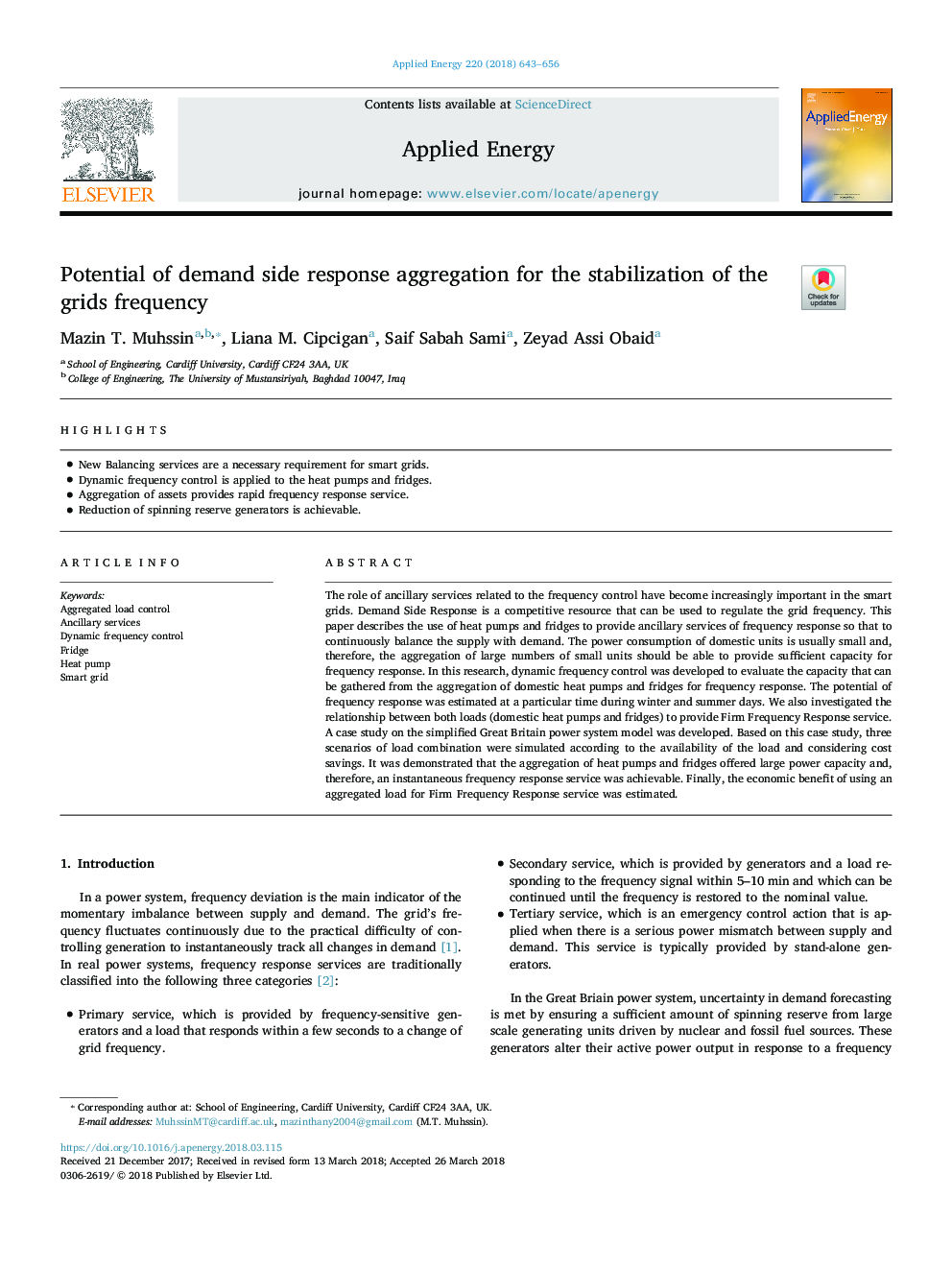| کد مقاله | کد نشریه | سال انتشار | مقاله انگلیسی | نسخه تمام متن |
|---|---|---|---|---|
| 6680369 | 1428070 | 2018 | 14 صفحه PDF | دانلود رایگان |
عنوان انگلیسی مقاله ISI
Potential of demand side response aggregation for the stabilization of the grids frequency
ترجمه فارسی عنوان
پتانسیل تجمع واکنش سمت تقاضا برای ثبات فرکانس شبکه
دانلود مقاله + سفارش ترجمه
دانلود مقاله ISI انگلیسی
رایگان برای ایرانیان
کلمات کلیدی
کنترل بار جمع شده خدمات جانبی، کنترل فرکانس پویا، یخچال، پمپ حرارتی، شبکه هوشمند،
ترجمه چکیده
نقش خدمات جانبی در ارتباط با کنترل فرکانس در شبکه های هوشمند به طور فزاینده ای مهم است. پاسخ جانبی تقاضا یک منبع رقابتی است که می تواند برای تنظیم فرکانس شبکه استفاده شود. این مقاله استفاده از پمپ های حرارتی و یخچال ها را برای ارائه خدمات جانبی فرکانس پاسخ می دهد تا به طور مداوم با عرضه تقاضا را متعادل سازد. مصرف برق واحدهای داخلی معمولا کوچک است و بنابراین جمع شدن تعداد زیادی واحدهای کوچک باید بتواند ظرفیت کافی برای پاسخ فرکانس را فراهم کند. در این تحقیق، کنترل فرکانس پویا برای ارزیابی ظرفیت که می توان از جمع آوری پمپ های حرارتی داخلی و یخچال ها برای پاسخ فرکانسی جمع آوری کرد، توسعه داده شد. پتانسیل پاسخ فرکانس در یک زمان خاص در طول روزهای زمستان و تابستان تخمین زده شد. ما همچنین رابطه بین هر دو بار (پمپ های حرارتی خانگی و یخچال) را برای ارائه خدمات پاسخ فرکانسی شرکت بررسی کردیم. یک مطالعه موردی در مورد مدل ساده سیستم قدرت بریتانیا در حال توسعه بود. بر اساس این مطالعه موردی، سه سناریو ترکیب بار با توجه به دسترسی بار و با توجه به صرفه جویی در هزینه، شبیه سازی شده است. نشان داده شد که تجمع پمپ های حرارتی و یخچال ها ظرفیت بالاتری را ارائه می دهد و بنابراین یک سرویس پاسخ فرکانسی لحظه ای امکان پذیر است. در نهایت، مزیت اقتصادی استفاده از بارگیری تلفیقی برای خدمات پاسخ فرکانس شرکت برآورد شد.
موضوعات مرتبط
مهندسی و علوم پایه
مهندسی انرژی
مهندسی انرژی و فناوری های برق
چکیده انگلیسی
The role of ancillary services related to the frequency control have become increasingly important in the smart grids. Demand Side Response is a competitive resource that can be used to regulate the grid frequency. This paper describes the use of heat pumps and fridges to provide ancillary services of frequency response so that to continuously balance the supply with demand. The power consumption of domestic units is usually small and, therefore, the aggregation of large numbers of small units should be able to provide sufficient capacity for frequency response. In this research, dynamic frequency control was developed to evaluate the capacity that can be gathered from the aggregation of domestic heat pumps and fridges for frequency response. The potential of frequency response was estimated at a particular time during winter and summer days. We also investigated the relationship between both loads (domestic heat pumps and fridges) to provide Firm Frequency Response service. A case study on the simplified Great Britain power system model was developed. Based on this case study, three scenarios of load combination were simulated according to the availability of the load and considering cost savings. It was demonstrated that the aggregation of heat pumps and fridges offered large power capacity and, therefore, an instantaneous frequency response service was achievable. Finally, the economic benefit of using an aggregated load for Firm Frequency Response service was estimated.
ناشر
Database: Elsevier - ScienceDirect (ساینس دایرکت)
Journal: Applied Energy - Volume 220, 15 June 2018, Pages 643-656
Journal: Applied Energy - Volume 220, 15 June 2018, Pages 643-656
نویسندگان
Mazin T. Muhssin, Liana M. Cipcigan, Saif Sabah Sami, Zeyad Assi Obaid,
